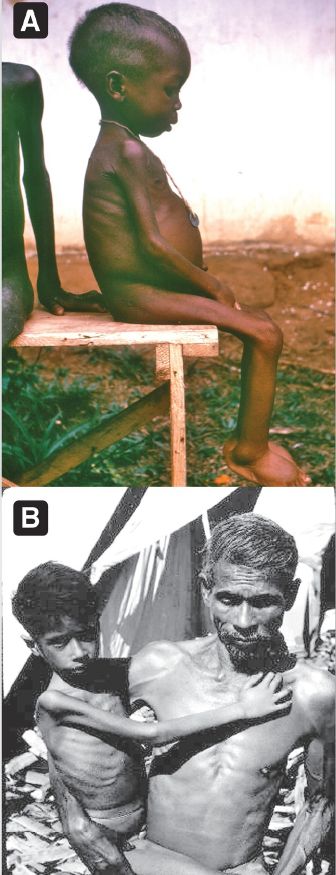
Protein-energy (calorie) malnutrition
 المؤلف:
Denise R. Ferrier
المؤلف:
Denise R. Ferrier
 المصدر:
Lippincott Illustrated Reviews: Biochemistry
المصدر:
Lippincott Illustrated Reviews: Biochemistry
 الجزء والصفحة:
الجزء والصفحة:
 7-12-2021
7-12-2021
 2019
2019
Protein-energy (calorie) malnutrition
In developed countries, protein-energy malnutrition (PEM), also known as protein-energy undernutrition (PEU), is most commonly seen in patients with medical conditions that decrease appetite or alter how nutrients are digested or absorbed or in hospitalized patients with major trauma or infections. [Note: Such highly catabolic patients frequently require intravenous (IV, or parenteral) or tube-based (enteral) administration of nutrients.] PEM may also be seen in children or the elderly who are malnourished. In developing countries, an inadequate intake of protein and/or calories is the primary cause of PEM. Affected individuals show a variety of symptoms, including a depressed immune system with a reduced ability to resist infection. Death from secondary infection is common. PEM is a spectrum of degrees of malnutrition, and two extreme forms are kwashiorkor and marasmus (Fig. 1). [Note: Marasmic kwashiorkor has features of both forms.]

Figure 1: Physical features of extreme protein-energy malnutrition (PEM) in
children. [Note: The fatty liver and skin and hair changes of kwashiorkor are not
seen in marasmus.]
1. Kwashiorkor: Kwashiorkor occurs when protein deprivation is relatively greater than the reduction in total calories. Protein deprivation is associated with severely decreased synthesis of visceral protein.
Kwashiorkor is commonly seen in developing countries in children after weaning at about age 1 year, when their diet consists predominantly of carbohydrates. Typical symptoms include stunted growth, skin lesions, depigmented hair, anorexia, fatty liver, bilateral pitting edema, and decreased serum albumin concentration. Edema results from the lack of adequate blood proteins, primarily albumin, to maintain the distribution of water between blood and tissues. It may mask muscle and fat loss.
Therefore, chronic malnutrition is reflected in the level of serum albumin. [Note: Because caloric intake from carbohydrates may be adequate, insulin levels suppress lipolysis and proteolysis. Kwashiorkor is, therefore, nonadapted malnutrition.]
2. Marasmus: Marasmus occurs when calorie deprivation is relatively greater than the reduction in protein. It usually occurs in developing countries in children younger than age 1 year when breast milk is supplemented or replaced with watery gruels of native cereals that are usually deficient in both protein and calories. Typical symptoms include arrested growth, extreme muscle wasting and depletion of subcutaneous fat (emaciation), weakness, and anemia (Fig. 2). Individuals with marasmus do not show the edema observed in kwashiorkor. [Note: Refeeding severely malnourished individuals can result in hypophosphatemia , because any available phosphate is used
to phosphorylate carbohydrate intermediates. Milk is frequently given
because it is rich in phosphate.]

Figure 2: A. Listless child with kwashiorkor. Note the swollen belly and lower legs. B. Child suffering with marasmus.
Cachexia, a wasting disorder characterized by loss of appetite and muscle atrophy (with or without increased lipolysis) that cannot be reversed by conventional nutritional support, is seen with a number of chronic diseases, such as cancer and chronic pulmonary and renal disease. It is associated with decreased treatment tolerance and response and decreased survival time.
 الاكثر قراءة في الكيمياء الحيوية
الاكثر قراءة في الكيمياء الحيوية
 اخر الاخبار
اخر الاخبار
اخبار العتبة العباسية المقدسة


